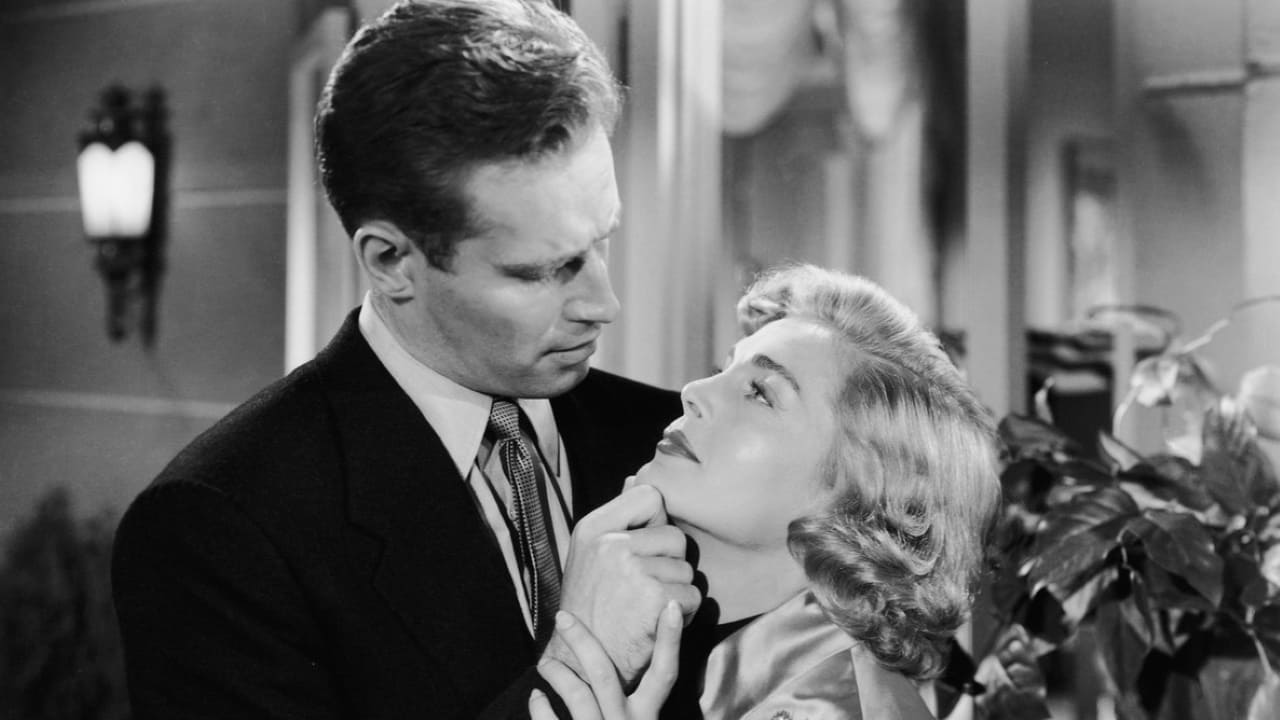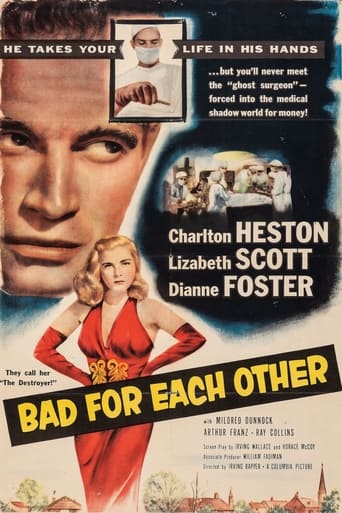

Charlton Heston and Lizabeth Scott are "Bad for Each Other" in this predictable 1953 film, also starring Mildred Dunnock, Arthur Franz, Marjorie Rambeau, and Dianne Foster. Heston plays a doctor who returns from the service to the coal town where he grew up. After meeting the wealthy, twice-married, shallow Scott, he decides not to stay in the service and becomes a society doctor, in it for the money. The nurse he hires to work for him (Foster) thinks he's better than that. The role played by Arthur Franz, that of a young doctor who admires him and doesn't mind going into the trenches, is essentially Heston's conscience.I found this film pretty bland, but the big problem for me was that the main character as portrayed by Heston was just not likable. He wasn't likable before he took up with Scott nor was he likable throughout the film. Some of this was in the script, but some of it was in his line readings. He had fat attitude every time he opened his mouth. Frankly I didn't care what he did.Lizabeth Scott was best earlier in her career, in her noir days, where her great voice, sexy blond looks, and ambiguous performances fit very well. Her character in this also was annoying. Now, she's not supposed to be likable, but we should have been able to see why Heston liked her. She seemed awfully pushy for his character to have put up with her.Heston was tall, handsome, with a great voice and a dominating presence. This film was unfortunately directed in a somewhat old-fashioned manner so as to seem melodramatic and over the top. When someone with that strong a screen persona is directed that way, his performance becomes too actor-y.Nothing special.
... View MoreBad for Each Other (1953)Charlton Heston gets a bad rap sometimes--maybe that's what you expect after "Planet of the Apes"--but here he is the charming, confident, larger than life young man that made him famous. Yes, it's a B-movie, but it's a very strong performance for Heston and he is surrounded by a cast that is decent (Lizabeth Scott not at her best, which is saying a lot) to terrific (Ray Collins as the big business power guy he plays so well). The "business" at the center is a coal mine in a small Pennsylvania town, and Heston plays a doctor, Tom Owen, getting out of the military in a pseudo-noir kind of echo. Owen's dilemma is a worldly one--whether to doctor rich old women with frivolous pains or to work for the miners in their lower class afflictions.And it is Lizabeth Scott, a pampered (and unabashedly pampered) rich girl who snags our hero, and so against his initial instinct Heston goes the rich and lazy way. But of course the coal mining town is all around him, and reminders pop up now and then. It's a great problem for a movie, and it's worked out with fairly predictable logic, so there is nothing to really fault here. Except that very predictability. Even Scott is a bit bland, not really getting to run her coolness to true ice. Some of the side characters are well developed, surprisingly (a "good" doctor untainted by money and an old woman who is wiser than she lets on at first), and director Irving Rapper (who should have been a music star in the 1990s with a name like that) makes it pop pretty well.The less than sterling reputation of this movie is unwarranted, but it may be a result of higher expectations than this kind of movie deserves. Yes, the plot is boilerplate stuff, but so are half the movie plots out there. And Heston is sort of terrific. Yes, he plays a type, and he doesn't give the angst some other actor might, but I don't think the character, Dr. Owen, was an angst-y kind of guy. The way he wrestles with things is believable.The cinematography by Franz Planer is better than I'd expected (the name didn't ring a bell) and there are small sterling moments, the camera moving around a group of people at a table, or across a wrought iron screen as the two leads start to hit it off. Nice stuff. The title is wrong, by the way--it's only Scott's character who is bad for the doctor, not the other way around. She's not about to be affected by anyone, especially a handsome young ex-GI who is such easy prey.
... View MoreThis Columbia film is an abbreviated reworking of MGM's THE CITADEL (1938). In THE CITADEL a young doctor treats miners in Wales, but then sells out to treat rich hypochondriacs in London, before rediscovering his ethics in the end. In BAD FOR EACH OTHER, it's miners in Coalville vs. rich women in Pittsburgh. There are many other similarities, although BAD reshuffles the plot elements into a shorter running time. A mine disaster sequence, common to both films, is egregiously duplicated in BAD, including some shots which are near-identical. It's close to plagiarism. THE CITADEL is a great film, while BAD is merely entertaining. Just don't watch them within a month of each other, as I accidentally did.
... View MoreBefore watching this movie, I bethought myself, with Charlton Heston, Liz Scott, and Ray Collins, presented in early '50's beautiful black and white, it can't be all bad. How wrong I was. Bad for Each other was just bad for viewing. The cinematography was gorgeous, all right, and the cast was good, all right, but both were wasted on this movie.I will not waste time on the plot. Too much ink has already been spilled going over its standard "The Citadel" pattern doctor-torn-between-being- noble-helper-of-mankind-and-making-money story line. It has been used over and over again because it works well. In Hollywood when they found a horse that would run, they just went ahead and rode him to death. And that's not so bad. But this was a very poor treatment of the familiar story.The development of the story was incompetent and contrived. The story had so many plot threads, it would have taken a two and a half hour movie to cover them all, but this second feature programmer was only 84 minutes. We were led to expect that the X-rays of the miners' lungs displaying some hard-to-diagnose disease, shown to Dr. Heston by both the old coal mine doctor (Rhys Williams) and his idealistic young assistant (Arthor Franz) would turn out important in the denouement. Likewise the issue of whether Heston's character intended to pay off his late brother's debts. But there was no payoff on either. Both were left hanging at the end. People, including her own father, kept telling Heston how bad spoiled society dame Liz Scott had been for all men and how she would ruin him. But he seemed to be developing all of his bad attitude on his own without her help. Her attempts to manipulate him had little effect. In fact he seemed to dominate her.The characterization in general was very bad. The noble poor -- Heston's mother (Mildred Dunnock), the dedicated nurse (Dianne Foster), and Franz's idealistic young doctor -- all came off like doctrinaire commie stereotypes. All of the rich people were likewise portrayed like socialist models of capitalistic pigs, the exception being Ray Collins' mine owner, who showed a little troubled noblesse oblige. I'm not suggesting it was made from a socialist point of view. I'm not sure the movie even had a point of view. It was just crude. If the commies couldn't do any better than that in the propaganda department, no wonder they lost the Cold War!The cruelest disappoint of all awaited us Liz Scott fans. What a waste of that dynamite figure, that wicked, toothy leer, those vampire eyes, and that awesome ability to be bad,bad, bad! So bad that in another, much better, movie Too Late for Tears she even made Dan Duryea look like a half -decent guy by comparison! She never got to be really bad in this movie, just a bit spoiled and selfish. I kept waiting for her to shoot someone, poison someone, double-cross someone, or just run off with the plumber. Any of the above would have considerably improved this movie. Unfortunately nothing so interesting happened.No, Liz wasn't bad, but Bad for Each Other was.
... View More